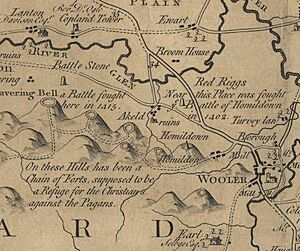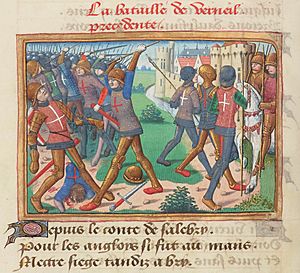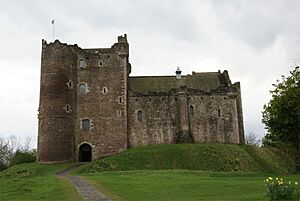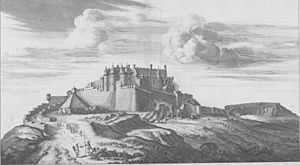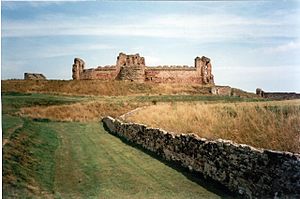Murdoch Stewart, Duke of Albany facts for kids
Quick facts for kids Murdoch Stewart |
|
|---|---|
| Duke of Albany, Earl of Fife & Menteith | |
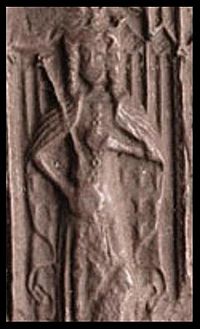
Detail from the seal of Murdoch Stewart
|
|
| Governor of Scotland | |
| Tenure | 1420–1424 |
| Predecessor | Robert Stewart |
| Successor | James I (as king) |
| Born | 1362 |
| Died | 24 May 1425 |
| Spouse | Isabella, Countess of Lennox |
| Issue | Robert Stewart Walter Stewart Alexander Stewart James the Fat Isabel |
| House | Stewart (Albany branch) |
| Father | Robert Stewart, Duke of Albany |
| Mother | Margaret, Countess of Menteith |
Murdoch Stewart, Duke of Albany (1362–24 May 1425) was an important Scottish nobleman. He was the son of Robert Stewart, Duke of Albany, and the grandson of King Robert II of Scotland. King Robert II started the Stewart dynasty, a family of Scottish kings.
In 1389, Murdoch became a top judge in northern Scotland. In 1402, he was captured during the Battle of Homildon Hill. He spent 12 years held captive in England.
After his father died in 1420, Murdoch became the Governor of Scotland. This was while the future King James I of Scotland was also held captive in England. Murdoch served as governor until 1424. That year, James was finally freed and returned to Scotland.
However, in 1425, soon after James became king, Murdoch was arrested. He was found guilty of acting against the king and was executed. Two of his sons were also put to death. His only son who survived was James the Fat. He escaped to Antrim, Ireland, where he died in 1429. Murdoch's wife, Isabella of Lennox, survived this difficult time. She later saw King James I killed and got her lands back.
Contents
Early Life and Family
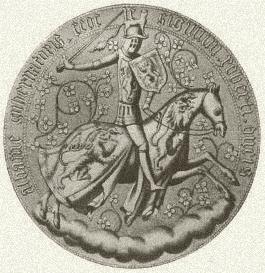
Murdoch Stewart was born in 1362. He was the only son of Robert Stewart, Duke of Albany (1340–1420). His mother was Margaret Graham, Countess of Menteith.
His father, Duke Robert, was a very powerful Scottish nobleman. He served as Regent of Scotland many times. This happened during the reigns of three kings: Robert II, Robert III, and James I.
Duke Robert held several important titles. These included Earl of Menteith and Earl of Fife. The Albany Stewarts were very rich and powerful. They were also possible heirs to the Scottish throne. Murdoch's grandfather was King Robert II of Scotland. He was the first king from the Stewart family.
Murdoch grew up in a large family. He had eight sisters:
- Janet Stewart
- Mary Stewart
- Margaret Stewart
- Joan Stewart
- Beatrice Stewart
- Isabella (Isobel) Stewart
- Lady Marjorie Stewart
- Lady Elizabeth Stewart
His mother, Margaret, died in 1380. His father married again to Muriella de Keith. They had four children, including John Stewart, 2nd Earl of Buchan.
In 1389, when Murdoch was about 27, he became a top judge. This role was called Justiciar North of the Forth. He and his father worked together to increase their family's power. This sometimes led to conflicts with other noble families.
War and Capture in England
Murdoch Stewart fought in Scottish battles against the English. In 1402, he was captured at the Battle of Homildon Hill. This battle happened on September 14, 1402, in Northumberland, England.
The Scottish army, led by Archibald Douglas, 4th Earl of Douglas, had gone into England to take goods. They wanted to get revenge for Scottish nobles killed or captured earlier. On their way back to Scotland, English forces stopped them. The English were led by Henry Percy, 1st Earl of Northumberland. The Scottish army suffered a big defeat.
The famous writer William Shakespeare later wrote about this battle. In his play Henry IV, part 1, he mentions Murdoch Stewart. He calls him "Mordake the Earl of Fife" and says he was captured.
Murdoch Stewart was held as a prisoner in England for the next twelve years.
Political Power and the King's Return
Murdoch Stewart's time as a prisoner did not stop his father from gaining more power. In 1402, Murdoch's cousin, David Stewart, Duke of Rothesay, died. He was under the care of Murdoch's father at the time. King Robert III of Scotland was worried his younger son, Prince James, would face the same fate. James was the next in line for the throne.
So, King Robert III sent James out of Scotland in 1406. But James's ship was captured by English pirates. James became a prisoner of King Henry IV of England. Soon after, King Robert III died. Scotland was left without a king. Prince James, only 12 years old, spent 18 years held in England.
During this time, the Albany Stewarts took control of Scotland. Murdoch's father, Robert Stewart, Duke of Albany, became Governor of Scotland. He was like a king, but without the title. The English wanted to control Scotland if they returned James. Most Scots did not agree to this.
Murdoch Stewart was still a prisoner in England. But in 1416, he was exchanged for an English nobleman and returned to Scotland. The Albany Stewarts controlled the king's lands. This meant James had no income or royal symbols. Official records just called James "the son of the late king."
Governor of Scotland
In 1420, Murdoch's father died. Murdoch, now 58, finally inherited the title of Duke of Albany. He also became Earl of Fife and Earl of Menteith. Most importantly, he became Governor of Scotland himself. He held this powerful position from 1420 to 1424. King James I was still a prisoner in England during this time.
Murdoch did not seem to try very hard to get James back to Scotland. But eventually, political pressure forced him to agree to talks.
King James I Returns
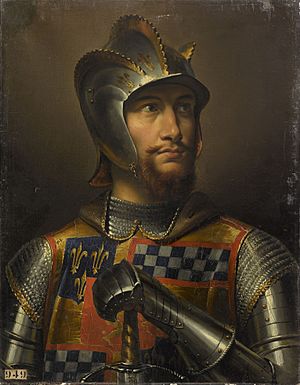
In August 1423, it was decided to send people to England to discuss James's release. A huge ransom of 60,000 Scottish marks was agreed upon in March 1424. James put his own seal on the agreement. He and his queen, with escorts, traveled to Melrose Abbey. They arrived on April 5, where James met Murdoch. Murdoch handed over his governor's seal of office.
When James I returned to Scotland, Murdoch lost his role as Regent. James began to strengthen his power as king. His coronation happened at Scone on May 21, 1424. At this event, James knighted 18 important nobles. This included Murdoch's son, Alexander Stewart.
At first, King James might have felt unable to act against the Albany Stewarts. This was because Murdoch's brother, John Stewart, Earl of Buchan, was fighting in France. He was with Archibald Douglas, 4th Earl of Douglas and their French allies. Buchan was a famous soldier. He commanded a large Scottish army of about 6,000 men. He was also Constable of France, meaning he led the entire French army.
However, both Buchan and Douglas were killed at the Battle of Verneuil in August 1424. The Scottish army was completely defeated. Losing these allies and their fighting force left Murdoch politically weak. James quickly moved against his Albany Stewart relatives soon after.
Arrest of the Albany Stewarts
Murdoch was arrested along with his younger son, Lord Alexander Stewart. Murdoch was first held in St. Andrews castle. Then he was moved to Caerlaverock Castle. His wife, Isabella, was captured at their family castle, Doune. She was sent to Tantallon Castle.
King James had reasons to be suspicious of the Albany Stewarts. His older brother, David Stewart, Duke of Rothesay, had died young. He was under the care of Murdoch's father at the time. Even though Parliament cleared Murdoch's father, people still suspected foul play. Also, neither Murdoch nor his father tried hard to get James released from England. This made James think the Albany Stewarts wanted the throne for themselves.
Murdoch's other son, Walter, was already in prison. James, Murdoch's youngest son (also known as James the Fat), escaped arrest. He fled and started a rebellion. He led men from Lennox and Argyll against the king. He attacked and burned the town of Dumbarton, causing many deaths. This violence by Murdoch's son likely pushed the king to charge the Albany Stewarts with acting against the crown.
Trial and Execution
Duke Murdoch, his sons Walter and Alexander, and Duncan, Earl of Lennox, were brought to Stirling Castle for their trial. This happened on May 18, 1425, with the King present. A group of seven earls and fourteen other nobles heard the evidence. The evidence linked the prisoners to the rebellion in Lennox. In a trial that lasted only one day, all four men were found guilty of acting against the king.
The jury that condemned them included some of Murdoch's own relatives. These included his half-uncle Walter Stewart, Earl of Atholl and his cousin Alexander Stewart, Earl of Mar.
Walter was found guilty on May 24. Murdoch and his son Alexander were tried by the same jury the next day. All the prisoners were publicly beheaded on Heading Hill. This was in front of Stirling Castle. Murdoch lost all his noble titles. He was buried at Blackfriars' Church, Stirling.
By destroying the Albany Stewarts, King James I gained a lot. He took control of the family's three rich earldoms: Fife, Menteith, and Lennox. The Albany Stewarts never recovered from this loss. More importantly, King James secured his rule. He removed the threat that the Albany Stewarts had posed to him for decades.
Marriage and Children
Murdoch was married to Isabella, Countess of Lennox. She was the daughter of Donnchadh, Earl of Lennox. They had four sons and one daughter:
- Robert Stewart (died 1421)
- Walter Stewart (executed 1425). He married Janet Erskine. Their children included:
- Andrew Stewart, 1st Lord Avondale. He became Lord of Avondale and Lord Chancellor of Scotland in 1459. He was a leading servant of King James III of Scotland. He held the Chancellor's office for 25 years.
- Walter Stewart of Morphie
- Alexander Stewart
* Henry Stewart, 1st Lord Methven. He married Margaret Tudor as her third husband. Her first husband was James IV of Scotland.
- Alexander Stewart (executed 1425).
- James the Fat (Seamas Mòr) Stewart. He fled to Ireland and died in 1429.
- Isabel. She married Sir Walter Buchanan.
Legacy
Murdoch's only surviving male heir was his youngest son, James the Fat. After his rebellion failed, James escaped to Ireland. He could not return to Scotland and died there in 1429. He was never able to inherit his father's titles, as they had been taken away.
Murdoch's grandson, James "Beag" Stewart (around 1410-1470), later received a pardon from the King. He returned to Scotland. However, the family never got back their lost lands. James "Beag" Stewart is an ancestor of the Stewarts of Ardvorlich. Their family history is told by Sir Walter Scott in his book A Legend of Montrose.
Murdoch's wife, Isabella of Lennox, survived the execution of her family. She spent eight years as a prisoner at Tantallon Castle. In 1437, after King James I died, she finally got her lands and titles back. She was allowed to rule her area from Loch Lomond. King James II of Scotland allowed her to use all her titles as Duchess of Albany and Countess of Lennox.
See also


